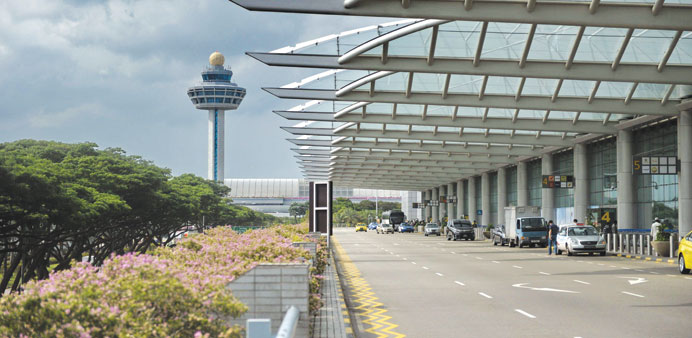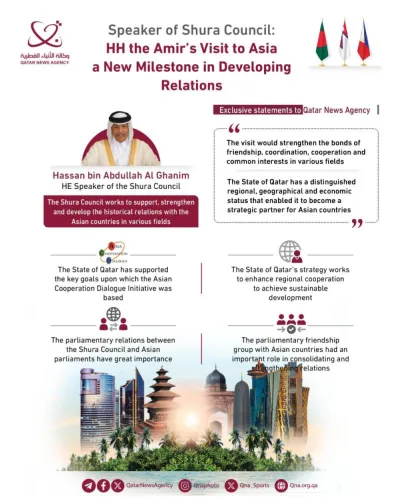The entrance to the departure hall for terminal 2 of Changi international airport in Singapore. Faced with snaking queues at immigration, overflowing baggage carousels and expensive flight delays, Asian nations are rushing to build hundreds of new airports to cope with surging demand for air travel in the region.
By Martin Abbugao/Singapore/AFP
Faced with snaking queues at immigration, overflowing baggage carousels and expensive flight delays, Asian nations are rushing to build hundreds of new airports to cope with surging demand for air travel in the region.
From China and India to the Philippines and Indonesia, the fast-growing middle classes are looking to spend their cash by spreading their wings, leading to a boom in the Asia-Pacific region’s tourism sector.
Airlines have responded by setting up several new budget carriers and flying new routes - but many airports are unable to cope, forcing governments to either expand or simply build new airports.
“Through the next 10 years, we see more than 350 new airports in the Asia-Pacific and the investment cost will be well over $100bn,” said Chris De Lavigne, a global vice president at business consultancy Frost & Sullivan Asia Pacific.
“China is building over 100 airports, India is building over 60 airports and Indonesia will also have to follow suit with investments in its infrastructure,” said De Lavigne, who closely tracks Asia’s aviation industry.
Upgrades of existing airports could cost an additional $25bn, he told AFP by telephone from his office in Jakarta.
International tourist arrivals in Asia-Pacific grew an annual 6.0% to 248mn last year, the strongest of any region worldwide, according to the UN World Tourism Organisation.
To cope with this, construction is being ramped up.
The Canada-based Airports Council International (ACI) said in a report that Indonesia plans to build 62 new airports in the next five years, in addition to its existing 237.
Soekarno-Hatta in Jakarta is improving capacity after handling 60mn passengers last year, nearly three times what it was designed for, ACI said.
And Kuala Lumpur aims to double capacity to 100mn a year by 2020, while Hong Kong wants to handle 97mn annually by 2030, up from 60mn in 2013.
In Beijing - which already has a hub servicing 80mn people - a second, $11bn airport is being built to open in 2018 and handle 40mn passengers, Sydney-based consultancy Centre for Aviation said.
There are also plans for a full replacement of Manila’s Ninoy Aquino International Airport, one of Asia’s most notorious for overcrowding and backward facilities.
Its Terminal 1, which is undergoing a major makeover, was built in 1981 to handle sixmn passengers a year.
Together with two extension terminals, the airport handled around 30mn passengers in 2013.
Even Singapore’s Changi - regarded by many as one of the world’s best - is expanding, with a $1.0bn Terminal 4 opening in 2017 that will raise capacity to 82mn passengers from the current 54mn. Plans are already being made for a Terminal 5.
Shukor Yusof, an analyst with Malaysia-based Endau Analytics, said airport infrastructure in many countries has lagged well behind travel growth.
“Many governments have paid scant attention to developing new terminals and new tarmacs, that’s why you find that many of the airports are bursting at the seams,” he told AFP.
The focus is not just on capitals. The need for more space means much of the new construction is taking place in secondary cities, with some facilities potentially becoming hubs.
De Lavigne cited the Kualanamu International Airport in Indonesia’s Medan, which opened last July and could become a hub for flights to Malaysia, Thailand, Myanmar, India and China.
It was designed to handle 8mn passengers a year but is already at capacity, he said.
“By 2025, they’re forecasting 24mn passengers out of Medan, or a three-fold increase in just over 10 years,” De Lavigne said, adding that Indonesia’s aviation sector alone is growing 14-15% a year.
Even less developed tourist destinations are pressing ahead with building.
Myanmar - returning to the global fold after decades of junta-led isolation - is looking to upgrade 39 airports as tourist and domestic air passenger figures are seen surging to 30mn in 2030 from 4.2mn in 2013, the ACI said.
The government is also building a new $1.5bn Hanthawaddy International Airport to serve as Yangon’s second airport, it added.
Bangladesh is constructing a new airport costing up to $7.2bn about 60km from Dhaka, ACI said.
Funding from governments and the private sector does not appear to be a problem.
Airports are now even targeting non-travellers, with the current trend for “aeroparks and aerotropolises” integrating lifestyle amenities, attracting diners and shoppers who won’t even board flights.
“You get people who don’t fly to come into the airports for food, shopping and other lifestyle activities. That trend which started in the West is increasingly finding its way into Asia,” De Lavigne said.



